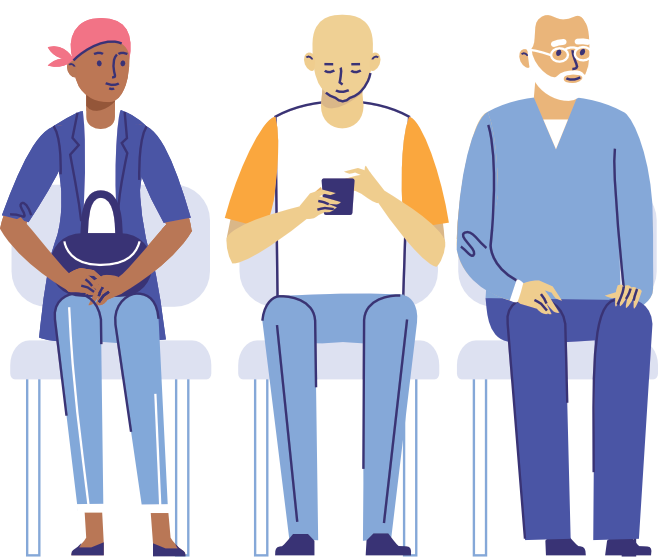After Treatment: Chronic pain
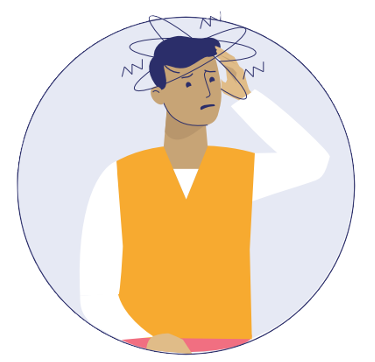
Why might I feel chronic pain after cancer treatment ends?
It is not unusual to continue to feel pain after cancer treatment ends. People suffer from chronic pain for a number of reasons. There are treatments that can help relieve the pain. The first step is understanding what type of pain you have. This will help you to know what is causing it.
Pain can be classified in different ways:
How long the pain lasts
- Acute pain: This comes on quickly but usually does not last long. It can be either mild or severe. It can be caused by injury, tissue damage, or inflammation. Acute pain that’s not well managed during active cancer may become chronic after treatment. Acute pain can last from hours to days, up to a few weeks.
- Chronic pain: This lasts longer than acute pain. It can last several months or even longer. It can range from mild to severe. It can be constant, or it can come and go. Chronic pain is caused by changes to the nerves. There are different things that could cause this. Sometimes this can be due to a tumour pressing on a nerve. It might also be due to the type of cancer treatment you received.
Where the pain occurs in the body
- Bone pain: This happens when the cancer spreads to the bone. It is often described as dull, throbbing, or aching.
- Nerve pain: This is due to pressure on the nerves or damage to the nerves. It is often described as burning or tingling.
- Soft tissue pain: This happens when there is damage to an organ or muscle. It can be described as aching, sharp, or throbbing.
- Visceral pain: This starts in the internal organs such as the abdomen (tummy) or chest. It is often described in vague terms such as “colicky.” Other symptoms, such as nausea and sweating, often occur with this type of pain.
There are also specific types of pain
- Referred pain: This is when there is pain in one part of the body but the injury is actually somewhere else. For example, if your liver is swollen, it could press on nerves. This pressure could cause pain in your shoulder instead of your liver.
- Phantom pain: This occurs when a part of the body has been removed. This is usually a limb such as a leg or an arm. Phantom pain refers to pain felt where the missing body part was. For example, you could feel phantom pain in a leg that is no longer there.
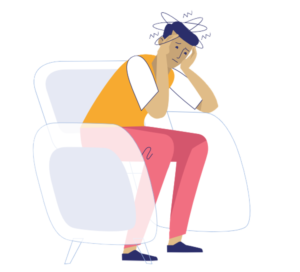
Not everyone continues to feel pain after cancer treatment ends. This depends on several things, including:
- The type of cancer you had.
- The stage of the cancer when it was discovered.
- The type of treatment you received.
- Your personal ability to tolerate pain.
How does it affect me?
Living with chronic pain can affect all aspects of your life. It can affect you physically, mentally, and emotionally. You may feel anger, fear, and worry, which can lead to mental health challenges such as anxiety or depression. It can also become difficult to carry out daily activities.
Will it get better?
You may have chronic pain for a short time, or it may last longer. The period depends on many reasons. This can include the type of treatment you received:
- Chemotherapy: It can cause nerve damage. This can cause a burning or tingling sensation called neuropathy. Usually, this type of pain goes away when the treatment ends. Sometimes the nerves are permanently injured, and the pain becomes chronic.
- Radiation: It can create sores or skin irritations that cause pain. These occur on the part of the body being treated.
- Surgery: It can lead to complications that cause pain.
With the right treatment, most pain can be controlled. There are many different options for managing pain. Most people begin treating their pain with medicine. Other options include massage therapy, acupuncture, surgery, and radiation. Your healthcare team can develop a treatment plan specific to you and your pain. See Communicating with your healthcare team.
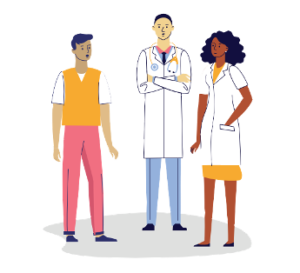
When should I get help for chronic pain?
It is important to tell your healthcare team about your pain. This will help them to find the cause. Tell them how bad the pain is and how it affects your life. Your healthcare team will find the right treatment for you. It is possible that your pain does not go away completely. They can still help you find ways to manage your chronic pain.
A pain diary is an important tool you can use to track and describe your pain. You can share this information with your healthcare team. This can help them to find ways to treat your pain. Your pain diary should include the following information:
- Write down where it hurts and be specific. For example, “right side of my lower tummy (abdomen)” rather than “stomach”.
- Describe the pain. Use words such as burning, dull, sharp, steady, or throbbing.
- Rate how intense the pain level is. For example, rate it on a scale of 0 to 10. Zero “0” is for no pain, and “10” is for the worst pain possible. For example, 1 could be a mosquito bite whereas 8-9 could be closing the car door on your fingers.
- Write down how long the pain lasts.
- Record what helps the pain to be better. For example, write if it is medicine, heat, or cold.
- Record what makes it worse. For example, record the time of day the pain is worse.
- Write the names of the pain medicines you take. Write the time you take them and how the medicine affects the pain. Do not forget to include any herbal remedies you are using to treat your pain.
You can create your own symptom diary. There are also pain diaries available on the internet. Here is one as an example.
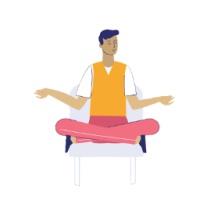
What can I do to manage my chronic pain?
Your healthcare team can create a plan for managing your pain. Your plan may include both medical and non-medical treatments. Different types of pain respond to different types of treatments. It is common to try many treatments before finding what is right for you. Try not to be discouraged if a treatment does not help.
Together, you and your healthcare team will learn what helps your pain. It is helpful to share with them what you wrote in your pain diary. It is common for a doctor to prescribe a basic pain medicine first, then increase the dose or strength of the medication as needed. Sometimes you might find the first one does not help your pain. Depending on your pain level, you may start on a stronger medicine. Sometimes a combination of drugs is needed to relieve the pain.
There is also a pain called “Breakthrough pain”. This happens before it is time for your next dose of pain medicine. The pain “breaks through” between doses of pain medicine.
If your pain medicine does not help enough, switching medicines may help. Sometimes your doctor may refer you to a pain specialist.
Medicines used to treat chronic pain can be given in different forms. These can be in the form of a pill, a skin patch, a suppository, or an injection.
Non-medical treatments
These may include psychological or physical approaches. Mindfulness and relaxation techniques are examples of psychological approaches. Examples of physical approaches may include physiotherapy and massage therapy.
Combining a non-medical treatment with pain medicine can better help relieve your pain. It is very important to discuss this with your healthcare team. They can review which options would be right for you. Not all treatments are safe for all patients. The following information describes possible treatment options that might be helpful.
- Acupuncture: This treatment is done by a specialist called an acupuncturist. For this treatment, the acupuncturist places very thin needles in the body. There is little discomfort since the needles are very thin. Special points are selected in the body that are believed to control pain. The needles remain for about 15 to 30 minutes and are then removed. If you would like to try this treatment, your healthcare team can recommend an acupuncturist, or you can use theservice locators below to find one near you.
- Biofeedback: This treatment uses a machine that provides information about your body. A biofeedback technician is specially trained to use the machine. Electrical sensors are placed on different parts of your body. There is little discomfort with this treatment. The information helps you learn to control some of your body functions. Body functions include your heart rate, blood pressure, and muscle tension. Learning to control body functions may help you learn how to manage your pain.
- Skin stimulation: Skin stimulation uses a series of different techniques on the skin. These include pressure, heat, cold, menthol preparations, or vibration. If you are considering any of these, discuss it with your healthcare team first. It is important to make sure that this is safe for you. Not everyone can use skin stimulation to relieve their pain.
- Cold and heat therapy: Cold can numb the painful area, helping to reduce the pain. Heat can help relieve sore muscles.
- For cold: You can use gel packs that are sealed in plastic. Gel packs are available in most drug stores and medical supply stores. They can be stored in the freezer and reused. They stay flexible when frozen. You can also use an ice pack or a bag of frozen peas. Another idea is to use a block of water frozen in a paper cup. You can cut into the paper cup to remove the block of ice, wrap the ice in a towel, and apply it directly to the area. It’s important to rotate the ice around the affected area.
When applying heat or cold on your skin, you should always place something in between so that the cold is not directly touching you. For example, wrap a towel around the ice pack or heat pack. This is more comfortable and prevents burns.
- For cold: You can use gel packs that are sealed in plastic. Gel packs are available in most drug stores and medical supply stores. They can be stored in the freezer and reused. They stay flexible when frozen. You can also use an ice pack or a bag of frozen peas. Another idea is to use a block of water frozen in a paper cup. You can cut into the paper cup to remove the block of ice, wrap the ice in a towel, and apply it directly to the area. It’s important to rotate the ice around the affected area.
- For heat: You can use a heating pad or gel pack soaked in hot water. The heating pad is available in most drug stores and medical supply stores.
Important Care Tips
- Do not leave cold or heat on you for more than fifteen minutes at a time. Always wait 15 minutes before applying it again.
- Do not use heat or cold directly on any area treated during the last six months. If you had radiation therapy, speak to your healthcare team.
- There are other precautions to take when using heat or cold. Your healthcare team can guide you on how best to use these methods.
- Massage: Depending on where your pain is located, you may need help with this. A family member, friend, or massage therapist can do the massage. Check with your healthcare team to make sure massage therapy is safe for you. If you plan to do it yourself, massage the area around your pain. Use slow, steady, circular motions. Some people find that light strokes are better than deep massage. Choose whichever method works best for your pain. You can find a certified massage therapist using the service locators below.
- Counselling and emotional support: Talking about your feelings can help reduce anxiety or depression. These two emotions can make your pain worse. A mental health professional can provide counselling and emotional support. You can speak with your doctor, nurse, or social worker. A member of the clergy, a family member, or a friend also can support you. You may consider joining a support group with others who have cancer. In these groups, members share their feelings and personal experiences to support each other. If you need help finding a support group in your area, ask your healthcare team or find one using the resources and service locators below.
- Distraction: You can learn to turn your attention away from your pain. This can be as simple as paying attention to something on television. Listening to music is another type of distraction. Or you can try counting or repeating a phrase to yourself. Working on a hobby you enjoy can also provide a good distraction.
- Hypnosis: This method puts a person into a calm trancelike state. It helps with relaxation and lessens the sensation of pain. If you consider using hypnosis, choose a hypnotist trained in the healing arts. Your healthcare team can help you find a skilled hypnotist.
- Imagery: Use your imagination to create a daydream that uses all your senses. This can include sight, hearing, touch, smell, and taste. For example, imagine a strong vacuum taking the pain out of your body: You can see it leaving your body. You can hear the vacuum and feel it. Maybe you can smell it and taste it in the air. Then you empty the pain into a jar and seal the jar tightly. How imagery eases the pain is not fully understood. It may be the result of a combination of distraction and relaxation. Some people believe it is a form of self-hypnosis.
Relaxation techniques can reduce muscle tension, lessen anxiety, and help you fall asleep. It also helps other pain-relief methods work better. There are many relaxation techniques that you can try. This can be done by sitting comfortably in a quiet place with your eyes closed. Keep your arms and legs uncrossed, since doing this can cause tingling or numbness after long periods of time.
Here are some techniques to help you relax and reduce stress:
- Breath focus: Take long, slow, deep breaths. As you breathe, distance your mind from distracting thoughts.
- Breath focus and body focus: After a few minutes of deep breathing, focus on one part of your body at a time. Then try to mentally release any physical tension you feel there.
- Guided imagery: Think of a soothing scene from memory or imagination. It can help you feel relaxed and at ease. You can close your eyes to imagine a relaxing or pleasant scene.
- Mindfulness meditation: Sit comfortably. Focus on your breathing as you concentrate your attention on the present moment. Do not let your mind drift to the past or the future. Just observe it without any judgment.
- Qigong, tai chi, and yoga: These ancient arts combine rhythmic breathing with a series of poses or flowing movements. The physical movements help you focus your mind. They also help keep other thoughts from distracting you. Check with your doctor before starting any of these to make sure that they are not too challenging.
- Repetitive prayer: Not everyone has to be religious to practice repetitive prayer. Being spiritually aware may make this technique more meaningful for you. Simply repeat a short prayer or phrase silently while practicing breath focus.
- For more information, see Relaxation Strategies.
Ask your healthcare team which relaxation techniques would be best for you. If your pain is severe, relaxation may not be enough. Before beginning the technique, wait for your pain medicine to start working.
For more information, you can listen to this audiobook on cancer and pain by the MacMillan Cancer Support Organization. You can also access their support groups here.
If you have questions on how to manage your pain, ask your healthcare team.
For additional support from those who are going through similar experiences, you can find Support Groups under services listed below.
Cannabis
Information about cannabis
Some patients use cannabis to help them manage cancer-related symptoms. However, overall, the research is still unclear. It is important to talk to your doctor before trying cannabis. For more information on what cancer patients should know about cannabis, go to: http://www.bccancer.ca/health-info/coping-with-cancer/medical-cannabis.
Available Services
The Quebec Cancer Foundation supports people with cancer and their loved ones throughout Quebec, through services suited to their needs and daily concerns.
Services offered
Several services and activities offered by the Quebec Cancer Foundation can be useful in managing your pain.
Guided meditation, Restorative Yoga, and Art therapy can help you with relaxation and distraction from your pain.
The foundation also offers Kinesiology, which can be adapted to your needs and help manage your pain. Massage therapy, walking clubs, therapeutic gymnastics can also help you get active. Use their resource directory below to find services near you.
Telephone peer-matching can connect you with someone who may have similar experiences. You can call the Info-Cancer hotline for more information and get the help you need.
Info-Cancer Library is a document lending service which covers a wide range of topics related to cancer. Their materials include books, web resources, online articles, and webcasts. They are free to borrow, and materials are sent by mail or email anywhere in Quebec.
Their information services also feature a virtual library.
Contact
1 (800) 363-0063
infocancer@fqc.qc.ca
https://cancerquebec.ca/en/
The mission of the Quebec Breast Cancer Foundation is to promote the well-being of cancer patients and their families through research, innovation, support and awareness.
They offer many services including information and support hotlines, as well as resources adapted to the needs of people affected by cancer and their families.
Services offered
My Active Health: a service that helps by offering physical activities on a regular basis which can help in relieving pain. Their activities include:
- My mobile application
- My exercise videos
- My oncologic Yoga
- Dragon Boat Teams
The Quebec Breast Cancer foundation offers psychosocial support and family counselling. The social workers from their support service can help with strategies to cope with your pain. You can contact their support help line here for private or peer support.
Free virtual clinic: a service of first aid offered to people affected by breast cancer. We aim to help manage the secondary effects that arise after treatment and those that persist long term. The clinic is:
- Easy-to-use
- Accessible 24/7
- Better monitoring and screening
- Management of secondary side effects that arise after treatment and those that stay permanent
- Promotion in health and healthy life habits
- Coordination of care between specialists and generalists
Contact
1-855-561-ROSE
soutien@rubanrose.org
General information
The Canadian Cancer Society offers support for people with cancer and their family, friends and caregivers.
Their information specialists are there to answer your questions and offer up-to-date, reliable information on topics that include:
- cancer treatment and side effects
- clinical trials
- coping with cancer
- emotional support services
- prevention
- help in the community
- complementary therapies
Services Offered
The Cancer Information helpline is available Monday to Friday in English and French from 6am to 6pm EST. For other languages, they can access an interpreter service.
Website and live-chat:
Talk to an information specialist | Canadian Cancer Society
Contact form:
Cancer information and support | Canadian Cancer Society
Online Community:
Cancer Connection| Canadian Cancer Society.
You can also access the CCS database below to find support services in your area.
Contact
(Toll free) number:
1-888-939-3333
Service locators
Below is a list of organizations that can help identify local support services for you and those that support you. The quality of the services has not been verified by e-IMPAQc. Before using these services, verify with your healthcare practitioner.
Canadian Cancer Society (National)
The Regroupement des Organisations Communautaires en Oncologie (ROCO) offers a service locator resource specific to the province of Quebec. It lists support resources available by region.
Contact
info@rocoqc.ca
514-506-3503
The Quebec Cancer Foundation offers a resources directory of community, association and public resources by region or postal code.
Contact
infocancer@fqc.qc.ca
1-800-363-0063 (Monday to Friday, 9 AM to 5 PM EST)
Acknowledgement of sources
The content of this document has been adapted from the following sources:
- American Cancer Society. Daily Pain Diary.
- American Cancer Society. Non-medical Treatments for Pain.
- Canadian Breast Cancer Network. Side Effects Management.
- Canadian Cancer Society. Life after Cancer Treatment.
- Canadian Cancer Society. Pain.
- Canadian Cancer Society. Pain Relief.
- Canadian Cancer Society. Tips for Managing Pain.
- Canadian Cancer Survivor Network. Pain.
- CancerCare Manitoba. Breakthrough Pain Diary.
- Cancer Support Community. Frankly Speaking about Cancer. Coping with Side Effects.
- Harvard Health Publishing. Six Relaxation Techniques to Reduce Stress.
- Self-Management British Colombia. Chronic Pain.
Healthcare professional endorsement
The content of this document has been reviewed and approved by a team of healthcare professionals and clinical experts.
Disclaimer
Please note that this fact sheet is not intended as a substitute for consultation with a healthcare professional. Rather, it was designed to complement interventions by your treating team. If you have questions about your health, or any medical issue, you should contact a healthcare professional right away. You should not delay seeking medical advice, or disregard professional medical advice, because of information in this fact sheet. Before beginning any health treatment, always consult your doctor. All care has been taken to ensure that the information contained in this document is accurate at the time of publication. e-IMPAQc is not responsible for any injury or damage to persons or property arising out of, or related to, any use of the fact sheet, or because of any errors or omissions.
Reproduction and copyright
Any reproduction or distribution, in whole or in part, of this webpage is prohibited without obtaining prior written consent of the e-IMPAQc project lead. Permission can be obtained by writing to e.impaqc.comtl@ssss.gouv.qc.ca.

